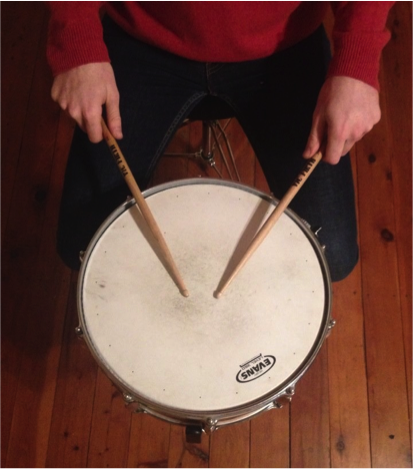Get a Grip! Matched Grip Under The Microscope
It is imperative that all drummers have a solid understanding of basic drum stick techniques and principles, so let’s take a closer look at matched grip and what it means for drummers.
First things first…
Improper grip technique can lead to pain, muscle tension and of course a limitation to what you can physically play. A correct grip and solid technical foundations will alleviate tension and allow the drummer to play with more speed, control, power and endurance. Whether you’re new to the drums or a seasoned professional, I highly recommend the constant maintenance and revision of key technique principles in order to facilitate yourself effectively behind the kit. Personally, I am still refining my technique and will be continuing to hone my skills for as long as I am behind the kit. Technique work is something that I feel is definitely ongoing, and always will be.
Varying drumming techniques and principles have evolved over the last century. The result is decades of trial and error in the search for the “best possible way to hit the drum”, leaving many drumming theorists divided. How many ways can you skin a cat? Are some specific techniques better than others? I am a strong advocate and longtime user of matched grip. As there are several ways to hold the drum sticks, I will be elaborating on my theories behind stick technique for Matched Grip, as I feel most comfortable with it and have been employing this grip the longest. I’m not saying that Matched Grip is the only practical technique to use. You should find the grip suits you, both physically and stylistically.
Before I deconstruct the theory and principles behind it I will outline a few universal technique concepts that are fundamental for all drummers. It is strongly advised that you learn to hold the stick loosely when you’re playing. Not loose enough that you have to wear eye protection, loose enough that the technique can work effectively and efficiently. The degree of severity of looseness will be discussed further down in this article. A tight, or “death grip” as it’s proverbially known, will make the drums sound bad (deathly) and kill your grooves instantly. Employing a tight grip can also result in severe tendon and/or nerve damage. As musicians who are essentially reliant on their hands continuously, injuries to the hands and arms are something that a drummer cannot afford to deal with.
What is the Matched Grip?
The Matched Grip, sometimes referred to as the overhand grip, is the most prevalent technique seen across drummers worldwide. The advantages of the Match Grip are obvious. Both hands use the same principle to hold the stick, unlike that of Traditional Grip which makes use of two different grips for each hand. Because your hands are effectively mirroring each other, you are performing the same procedure with each stick and you are more likely to obtain a consistent and full sound, with the added advantage of not having to learn how to hold the sticks twice!
For the Matched Grip, rest the stick in the palm of your hand with the tip pointing straight up between your thumb and pointer finger. As you close you naturally close your hand create a fulcrum point on the stick with your thumb and first finger. This fulcrum point is entirely dependent on the player and is most certainly likely to change from person to person, as we are all physically different. The stick should pivot freely in the fulcrum position and sit nicely in the first joint of the pointer finger with the thumb applying gentle pressure on top, only enough that if someone was to pull the stick out of your hand at any time while playing, they’d be able to do so easily.
Once the pivot point is assured the other fingers simply wrap around the stick with the same approach of the pointer finger, ensuring that they sit nicely along the first joint for each finger. To ensure your hand stays open and free while playing, endeavour to keep the sticks down in this position, rather than keeping them up in the palm of your hand.
Matched Grip Variants
Under Matched Grip fall 3 specific ‘sub-techniques’ or variations of the conventional gripping. These are known as the German Grip, French Grip and American Grip. Despite these opposing names the differences between them are subtle and wouldn’t be noticeable to the untrained musician.

The German Grip
With the German Grip, the player’s palms sit parallel to the drum, with the sticks forming an obvious right angle in rest position. The thumb sits on the side of the stick and the top of the hand sits flat. The idea behind this grip is that the action combines equal parts finger and wrist and gives the play the ability to generate great power with the use of inner forearm muscles.

The French Grip
The French Grip has the player’s palms sitting inwards or perpendicular to the drums head with the thumb placed directly on top. Also known as the ‘Timpani Grip’ the grip relieves the player of great wrist responsibilities with the focus of the stroke being generated primarily from finger and wrist action. The French Grip is widely employed by drummers who’re constantly playing at fast speeds; it allows for great control, finesse and of course speed with an impressive range of dynamic capabilities.

The American or Standard Matched Grip
The American Matched Grip is the most commonly used grip overall. Known as the ‘pick up and play grip’ because of its natural feel and intuitive nature it’s used by a lot of beginners, professional players and everyone in between. It’s the most natural way to hold the sticks and how most people innately want to hold them when first playing. The palms face neither completely down nor inwards. The American Grip is a hybrid of both the German and French Grips, seemingly taking the pro’s and con’s from each. It also requires minimal attention and prior training because of its instinctual and intuitive nature.
As aspiring musicians we should have an adept understanding of how our bodies respond to our respective crafts, whether it be Drums, Guitar or Piano. It is important that drummers doesn’t underestimate the physical and mental toll of the instrument. The best way to prepare yourself and ensure you’re well equipped for the task at hand is to have a solid foundation in basic technique principles. You have to walk before you can run.

